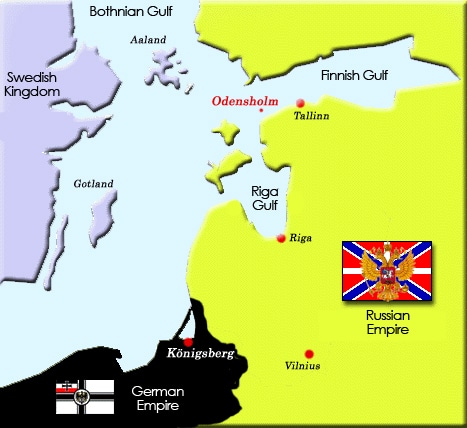
Mining the Gulf of Finland
Odensholm (currently Osmussaar, desolate island of 4.7 kilometers belonging to Estonia – where according to legend, Odin was burned at his funeral) was located 67 km southwest of Tallinn (59°17′30″N 23°23′30″E). By its strategic location, it closed the Gulf of Finland, gateway to the Baltic from St Petersburg. Upon declaration of war, it was entrusted to the care of the Hochseeflotte to lay mines at the entrance to the Gulf. On 25 August, were designated for this the cruisers Magdeburg and Augsburg. The first sailed from Königsberg (now Kaliningrad) and rallied the entrance to the Gulf during the night of August, 26.
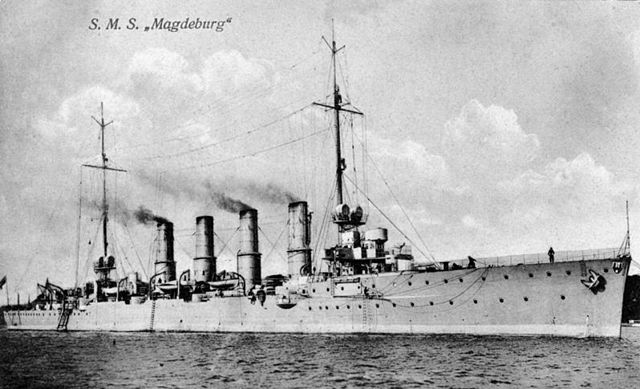
SMS Magdeburg, German light cruiser
Return of fate
Unfortunately the weather was foggy, and the Magdeburg ran aground on shoals north of the island of Odensholm, at only 200 m from the lighthouse at midnight past 38 minutes, when the starboard forward hit sand where water was only 2.5 meters deep. Escorting destroyer V26 tried to take her in tow for digging out, but in vain. However, from the nearby island Lighthouse, as the weather cleared up in the first lights, the Russian watchman gave the alarm to the headquarters of the Baltic Fleet. The naval base of Tallinn was only 50 miles away. Situation was now critical and Lieutenant Commander Habenitch orders the crew to evacuate the ship and prepare for scuttling.
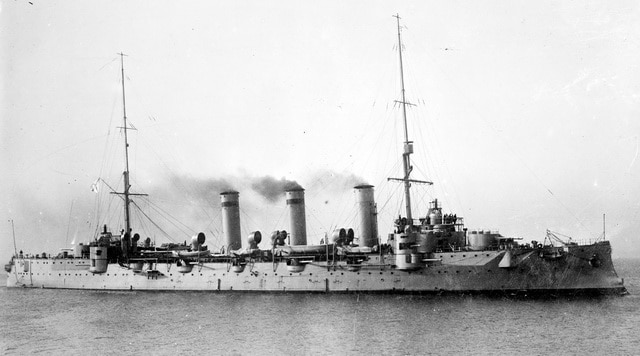
Russian cruiser Bogatyr
Engagement
Charges were laid, confidential archives are burned in a boiler. As the crew prepares to embark on the V26, a watchman signaled two Russians cruisers in sight. This was actually the Bogatyr, followed at a distance by the Pallada, that came through at 9.10 am. The V26 resumed abruptly boarding operations and left the area immediately, leaving the men left to their fate. The cruiser had not brought the colors yet, so the Russians cruisers opened fire in a blind spot: The German cruiser would not even have time or opportunity to replicate. After warning shots, seeing that the German cruiser failed to comply and bring the colors down, they shelled the ship at short range and quickly blown its superstructures up. A raging fire started, and the beginning of a panic seized the German crew. Moreover, charges at the front blown up at the same time, the back charges then being inactivated probably to left time to evacuate the ship. As a result, the ship essentially was left unscaved, as the Russians quickly stopped firing and sent a boarding party.
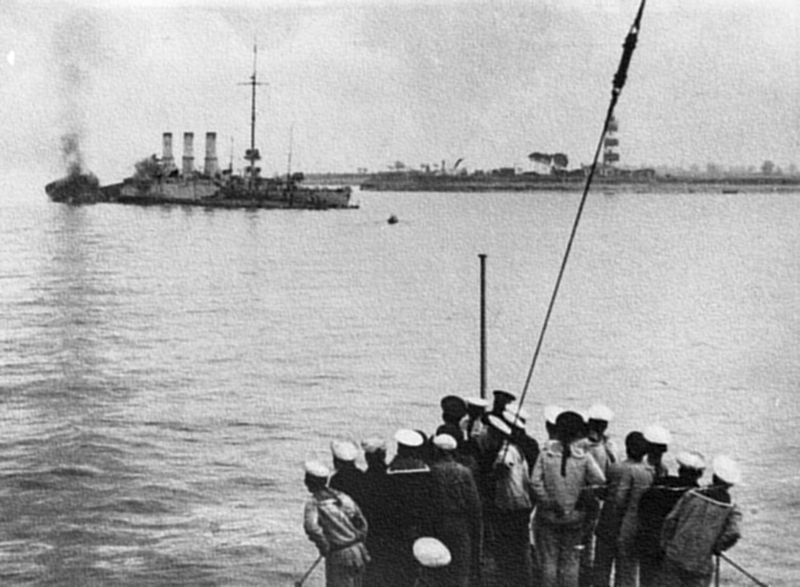
Stranded SMS Magdeburg being evacuated (seen probably from a Russian cruiser’s bridge), as the front part has been blown up. The lighthouse can be seen 200m in the background. (Bundesarchiv)
Aftermath
Ultimately, 56 sailors and Commander Richard Habenicht were captured, 17 dead, 21 wounded and 85 missing were declared. Captain Nepenin, chief of intelligence of the Baltic fleet sent a search team who to find a copy of the precious codes book of the Hochseeflotte, the Signalbuch der Kaiserlichen Marine (SKM), which was eventually discovered under a pile of clothes in the room of the commander. This document was indeed of paramount importance, giving precious intelligence to the allies.
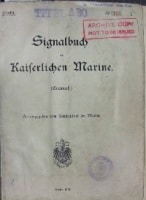 Moreover two others were also found with their decoding manuals attached: The around maps (containing coded squares). Two of these copied code books were sent to the fleet of the Baltic and the Black Sea, and the third one sent to London by captains Kedrov and Smirnof that delivered these personally to Winston Churchill, then 1st Lord of the Admiralty. Discovered also were the 4977.73 Marks, maps with the registered German minefields and corresponding secret codes.
Moreover two others were also found with their decoding manuals attached: The around maps (containing coded squares). Two of these copied code books were sent to the fleet of the Baltic and the Black Sea, and the third one sent to London by captains Kedrov and Smirnof that delivered these personally to Winston Churchill, then 1st Lord of the Admiralty. Discovered also were the 4977.73 Marks, maps with the registered German minefields and corresponding secret codes.
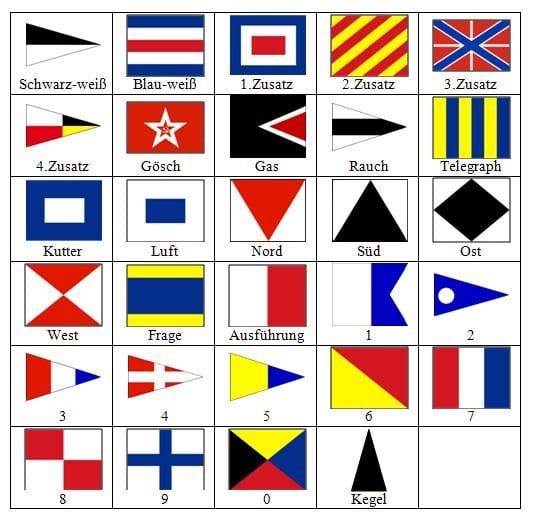
German signal flags.
These were immediately sent to the “Room 40” and intersected with other documents. From then on the Royal Navy and the Russian Navy will always have an edge over the Hochseeflotte. Indeed, the German staff ignored that the allies were now in possession of these ultra-secret documents, as the 56 men of the Magdeburg were held in Siberia until the capitulation. Moreover, in October 1914 the British also obtained the Imperial German Navy’s Handelsschiffsverkehrsbuch (HVB). This codebook was used by German naval warships, merchantmen, naval zeppelins and U-Boats. This case recalls another, which occur 19 years after: The seizing of enigma machines and breaking of the encryption code (which ultimately led to the invention of the computer).
Links & resources
Osmussar – Odensholm
German signal flags from 1815 (pdf)
The Code Bearers (Google book) By John Westwood
Das Ende von SMS Magdeburg
Room 40


 Latest Facebook Entry -
Latest Facebook Entry -  X(Tweeter) Naval Encyclopedia's deck archive
X(Tweeter) Naval Encyclopedia's deck archive Instagram (@navalencyc)
Instagram (@navalencyc)





 French Navy
French Navy Royal Navy
Royal Navy Russian Navy
Russian Navy Armada Espanola
Armada Espanola Austrian Navy
Austrian Navy K.u.K. Kriegsmarine
K.u.K. Kriegsmarine Dansk Marine
Dansk Marine Nautiko Hellenon
Nautiko Hellenon Koninklije Marine 1870
Koninklije Marine 1870 Marinha do Brasil
Marinha do Brasil Osmanlı Donanması
Osmanlı Donanması Marina Do Peru
Marina Do Peru Marinha do Portugal
Marinha do Portugal Regia Marina 1870
Regia Marina 1870 Nihhon Kaigun 1870
Nihhon Kaigun 1870 Preußische Marine 1870
Preußische Marine 1870 Russkiy Flot 1870
Russkiy Flot 1870 Svenska marinen
Svenska marinen Søværnet
Søværnet Union Navy
Union Navy Confederate Navy
Confederate Navy Armada de Argentina
Armada de Argentina Imperial Chinese Navy
Imperial Chinese Navy Marinha do Portugal
Marinha do Portugal Mexico
Mexico Kaiserliche Marine
Kaiserliche Marine 1898 US Navy
1898 US Navy Sovietskiy Flot
Sovietskiy Flot Royal Canadian Navy
Royal Canadian Navy Royal Australian Navy
Royal Australian Navy RNZN Fleet
RNZN Fleet Chinese Navy 1937
Chinese Navy 1937 Kriegsmarine
Kriegsmarine Chilean Navy
Chilean Navy Danish Navy
Danish Navy Finnish Navy
Finnish Navy Hellenic Navy
Hellenic Navy Polish Navy
Polish Navy Romanian Navy
Romanian Navy Turkish Navy
Turkish Navy Royal Yugoslav Navy
Royal Yugoslav Navy Royal Thai Navy
Royal Thai Navy Minor Navies
Minor Navies Albania
Albania Austria
Austria Belgium
Belgium Columbia
Columbia Costa Rica
Costa Rica Cuba
Cuba Czechoslovakia
Czechoslovakia Dominican Republic
Dominican Republic Haiti
Haiti Hungary
Hungary Honduras
Honduras Estonia
Estonia Iceland
Iceland Eire
Eire Equador
Equador Iran
Iran Iraq
Iraq Latvia
Latvia Liberia
Liberia Lithuania
Lithuania Mandchukuo
Mandchukuo Morocco
Morocco Nicaragua
Nicaragua Persia
Persia San Salvador
San Salvador Sarawak
Sarawak Uruguay
Uruguay Venezuela
Venezuela Zanzibar
Zanzibar Warsaw Pact Navies
Warsaw Pact Navies Bulgaria
Bulgaria Hungary
Hungary

 Bundesmarine
Bundesmarine Dutch Navy
Dutch Navy Hellenic Navy
Hellenic Navy Marina Militare
Marina Militare Yugoslav Navy
Yugoslav Navy Chinese Navy
Chinese Navy Indian Navy
Indian Navy Indonesian Navy
Indonesian Navy JMSDF
JMSDF North Korean Navy
North Korean Navy Pakistani Navy
Pakistani Navy Philippines Navy
Philippines Navy ROKN
ROKN Rep. of Singapore Navy
Rep. of Singapore Navy Taiwanese Navy
Taiwanese Navy IDF Navy
IDF Navy Saudi Navy
Saudi Navy Royal New Zealand Navy
Royal New Zealand Navy Egyptian Navy
Egyptian Navy South African Navy
South African Navy






























 Ukrainian Navy
Ukrainian Navy dbodesign
dbodesign